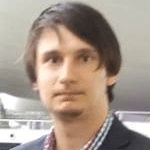by Jago Whale

Abstract
In light of the seemingly extremely counter-intuitive nature of quantum mechanics and the peculiar behaviour of quantum particles, it can be extremely difficult if not impossible to envisage what is actually happening on the length scales involved. The Ring Polymer Method provides a versatile tool for doing this in that there exists an isomorphism between the mathematics of a quantum particle in a heat bath and a particular classical ensemble. After all, it would be extremely cumbersome to perform a direct simulation of a quantum particle which at every instant of time tries every single path available to it from where it is to another point of interest, assigning to each path some ‘phase’, and sums all these amplitudes to arrive at something related to the probability that it will arrive there at the next instance of time. This is in essence Richard Feynman’s “sum over paths” philosophy of quantum mechanics. This understanding of quantum physics was formulated rather beautifully in the language of mathematics and is known as the “path integral formulation of quantum mechanics”. An alternative approach would involve solving numerically a complex set of partial differential equations with specific boundary conditions.
Intro
The topic I chose to adopt would be the ring polymer method of modelling quantum behaviour. The Ring Polymer Method successfully allows us, by the aforementioned isomorphism, to simulate the quantum mechanical behaviour that we would otherwise have little intuitive comprehension of. Over the course of my study, was lead to the realization that the specific classical ensemble exhibits the same statistics as the quantum particle we modelled in this research project. By this method we transform mathematically the task of having to compute the contributions to the path integral by having a computer calculate explicitly the classical actions of a large number of possible paths and summing over their complex exponentials, into a task of simply sampling the configurations of a ring of masses.
Process
At first I began to gather all materials relating to Feynman’s “path integral formulation of Quantum Mechanics” from various books and online resources; this and some revision of the stochastic processes of particle diffusion, together with the study of two highly versatile areas of mathematics known as “Lebesgue Integration” and “Functional Calculus” (Also known less succinctly as “The Calculus of Variations”), formed the theoretical research portion of the project. The research portion of the project would also require the study of the partition function approach to thermodynamics known as Statistical Mechanics. After three weeks or so, I began the computational aspect of the study and began to familiarize myself almost ab initio with the computer language Python. As I reached the stage where the body of code for the simulation was written I used basic Lagrangian techniques to recover the precise dynamics of the classical ring polymer system and programmed python to iterate the simulation over many time increments, having discretized the temporal parameter. The precise classical system, of which the descriptive mathematics properly correspond to the quantum particle in a thermal bath, is a system of masses connected in circular fashion by spring-like forces or “bonds” consistent with Hooke’s law, suspended in some external harmonic potential and exposed to ambient thermally excited particles (of which the temperature is known) that induce Brownian motion in each of the elements of the ring of masses in the ring polymer by collision with them. After enough time iterations a histogram of the positions can be built up and a distribution function for the position is the result.
Results
After some statistical analysis and various plots were produced, there arose a very distinctive and well known form for the position probability distribution, namely a Gaussian or “Normal Distribution”, which entirely agrees with the predictions of the usual differential formulation of quantum theory as retrievable from the ground state solution of the time-independent Schrodinger Equation for the quantum harmonic oscillator.
Conclusion
Not only is this is a hugely useful method for simulating the behaviour of quantum particles without having to program a computer to explicitly calculate the classical actions of an enormous multitude of quantum paths (of which there exists a high order of infinity), it also, in my view, represents an invaluable teaching resource for anyone attempting to present the strange concepts involved in quantum mechanics to those starting out in it. This method most notably never required us to actually retrieve the wave equations for all energy levels of the particle, which can instead be done by changing the temperature of the heat bath in the Ring Polymer Simulation.
Studying and implementing the ring polymer method UROS research project has, over its course, equipped me with extremely powerful post graduate level mathematical tools and advanced understanding of physics for attacking complex problems; certainly a highly sought after skill. The UROS research internship scheme has been hugely enriching. The knowledge I have acquired will aid me in my final year of university and perhaps provide me with a great platform from which to plunge into scientific academia should I so choose. The UROS research scheme has been well worth the effort and I would recommend it to any who can spare their summer for further, paid, reading into their respective subjects and at the same time gathering invaluable experience for their CV.
References
[1] R. P. Feynman, A. R. Hibbs, Quantum Mechanics and Path Integrals, Emended ed., Mineola, NY: Dover, 2010.
[2] J. R. Taylor, Classical Mechanics, Mill Valley, California: University Science Books, 2005.
[3] A. I. M. Rae, Quantum Mechanics, 5th ed., Birmingham, UK: Taylor & Francis, 2007.
[4] C. Lanczos, The Variational Principles of Mechanics, 4th ed., Toronto, Canada: University of Toronto Press, 1970.
[5] M. E. Tuckerman, Statistical Mechanics: Theory and Molecular Simulation, Oxford, UK: Oxford University Press, 2010.
*To view Jago’s project poster, please click on the thumbnail below:

